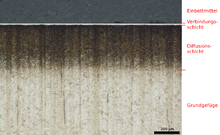Nitriding
The nitriding (chemically correct actually nitriding ) is fachsprachlich as nitriding (supply of nitrogen in analogy to the supply of carbon in the carburizing ) designates and provides a method for hardening of steel . It belongs to the outline of the manufacturing process "to the group change material properties " . The term nitriding or nitriding , which is common in technology , often leads to misunderstandings, because in chemistry this is usually used to describe processes that lead to nitrates or nitro compounds , while in the process described here nitrides are formed in the materials. For this reason, the use of the term nitriding is advocated, although it has not yet been able to establish itself in practice.
Procedure
Nitriding is a method of surface hardening. Nitrogen is used for this. A surface layer is created that is resistant up to around 500 ° C.
The manufacturing process is usually carried out at temperatures of 500 to 520 ° C for treatment times of 1 to 100 hours, the core of the material remaining ferritic and the formation of austenite close to the surface is avoided by the diffusion of nitrogen . A distinction is made between gas nitriding (in an ammonia atmosphere at a slight excess pressure), bath nitriding (in salt baths) and plasma nitriding . With bath nitriding, partial immersion of the workpieces is possible, with plasma nitriding, for example, you can mechanically cover with the clamping device.
A very hard superficial connecting layer ( ε- and γ'-iron nitride ) forms on the workpiece surface due to the diffusion of nitrogen into the component surface , which, depending on the treatment time and temperature, can be a few tenths of a millimeter thick and more or less pronounced pore seams on the surface which can in turn be used as a carrier of, for example, lubricants. Nitriding without a connection layer, for example for subsequent chemical or galvanic coating, is possible. The diffusion zone, in which the nitrogen is stored up to a certain depth in the ferritic metal matrix, is located under the connecting layer. This nitrogen stored in solid solution leads to an increase in fatigue strength . The so-called nitriding hardness depth (NHD), (old term “nitriding hardness depth” (Nht)) is defined by the hardness limit. The hardness limit is 50 HV above the core hardness of the workpiece. Particularly high hardness in the diffusion zone can be achieved with so-called nitriding steels .
In order to increase the corrosion protection of these layers, it is possible to oxidize the connecting layer. This is usually done by applying steam, which causes the iron components to corrode and thus forms a protective oxide layer ( steam tempering ).
Advantages of nitriding compared to conversion hardening processes are the higher heat resistance up to 600 ° C and the fact that the component is not deformed by the hardening process, so that finishing can be carried out before hardening. Disadvantages are the long glow times and the toxicity of some of the chemicals required.
Individual evidence
- ↑ a b Catrin Kammer, Hans Krämer, Volker Läpple, Johann Scharnagl: Material Science for Practitioners , Europe, 2000, ISBN 3-8085-1325-X , p. 67 f.
- ↑ Berns, Theisen: Eisenwerkstoffe , Springer, 2013, 4th edition, p. 227
- ^ Bargel, Schulze: Material science , Springer, 11th edition, 2012, p. 226.
